
Piantagioni di tè
Le piantagioni di tè dello Sri Lanka, situate principalmente sugli altopiani centrali, sono rinomate per la produzione di alcuni dei tè più pregiati al mondo. Queste lussureggianti piantagioni, come quelle di Kandy, Nuwara Eliya e Hatton, offrono paesaggi panoramici e una ricca storia. Le piantagioni contribuiscono in modo significativo all'economia del paese, esportando tè di Ceylon di alta qualità in tutto il mondo.

Regioni del tè di Ceylon
L'infuso nella tua tazza ha una storia da raccontare. Parla di dolci colline, sole splendente e province lussureggianti. In Sri Lanka, le province centrali e meridionali producono la maggior parte del tè. Le diverse altitudini e i microclimi influenzano il sapore, il colore, l'aroma e la stagionalità caratteristici del tè di Ceylon.

Gradi del tè nero di Ceylon
Il tè di Ceylon, come lo conosciamo oggi, è disponibile in diverse varietà, ognuna con sapori e aromi unici. Oltre alla varietà di tè, il tè di Ceylon è suddiviso in diverse qualità.
Sabaragamuwa Tea
Sabaragamuwa is one of the biggest tea-growing regions in Sri Lanka. This growing region covers the western and southwestern and central mountains of the country.
The teas of Sabaragamuwa, in other words, Ruhuna, are mainly low-grown. all the estates range in elevation from sea level to around 2,500 feet.
The highest estates lie just below the boundaries of the Sinharaja and Peak Wilderness nature reserves. the environment consists of rainforests, cloud forests, and high grassy plains in this region.
As a result, they produce tea of a somewhat different character to that grown at lower elevations in the district. And also, some of these estates receive the highest rainfall of any in the plantation districts.
Other upper Sabaragamuwa estates receive some weather from the nearby Uva climatic system. Therefore, they produce in an entirely different way.
Sabaragamuwa produces a fast-growing bush with a long leaf, very black when withered, and well suited for ‘rolling’ (see manufacturer). The liquor, too, is similar to that of Ruhuna tea, dark yellow-brown with a reddish tint in the dry season, though lightening somewhat with altitude.
However, the ‘nose’ or aroma, is noticeably different from the Ruhuna product, with a hint of sweet caramel, and not quite as strong as the latter. The flavor, too, is strongly marked, especially with respect to low-grown examples.
These are general comments, However, and need not apply to all teas produced in Sabaragamuwa. The districts contain a number of sub-districts such as Ratnapura, Rakwana, Kaltura, Matara & Weligama close to the Southern coast.






